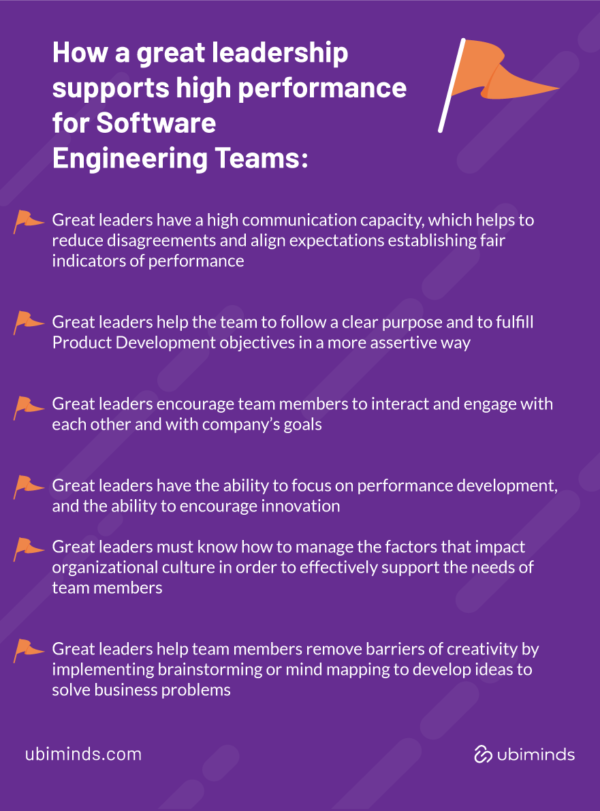The leadership management strategy has a direct influence on the Product Development Process and his performance. Depending on your methodology, a leader can become a facilitator and mediator for your team or a controller who gets in the way of things.
So it’s not a fallacy to say that leaders and their leadership methods are primarily responsible for building high-performance teams. From addressing customer needs to technical and financial feasibility to the concept of the idea, design and test it to release to the market, it’s crucial to impact the way the team works to achieve important goals.
But after all, what are the characteristics of great leadership that deliver high-performance results without struggling your team?
Content
Why is great leadership essential to High-performance software engineering?
A high-performance team is a group that brings together members committed to mutual growth and personal success which allows them to exceed all reasonable expectations and produces extraordinary results.
But, these teams are not going anywhere without a great leadership with whom the team can share a common vision, develop each step of their activities through open communication, and have shared leadership, build confidence, enabling innovation from individual differences.
The role of the leader has a significant impact on project teams and the involvement of the organization, which ultimately affects the team and its performance. The way the leader plans and manages engineers’ work, approaches organizational relationships and cultural differences, supporting the team’s problems, and giving solutions are fundamental to ensure that the project is delivered with quality and on time.
How a great leadership supports high performance for Software Engineering Teams
- Great leaders have a high communication capacity, which helps to reduce disagreements and align expectations establishing fair indicators of performance

How a great leadership supports high-performance Software Engineering Team
- Great leaders help the team to follow a clear purpose and to fulfill Product Development objectives in a more assertive way
- Great leaders encourage team members to interact and engage with each other and with the company’s goals
- Great leaders have the ability to focus on performance development, and the ability to encourage innovation
- Great leaders must know how to manage the factors that impact the organizational culture in order to effectively support the needs of team members
- Great leaders help team members remove barriers of creativity by implementing brainstorming or mind mapping to develop ideas to solve business problems
Leadership Styles
Some research shows that leadership styles have a direct relationship with the performance of the team. Because leadership influences team performance, organizations should invest in the development of their leaders, by various means such as training, coaching, and mentoring.
The leader patterns can be divided into two large groups, those with a focus on accomplishing tasks and others with a focus on people. Each one of these groups has its key traits which collaborate to boost high performance in software engineering teams.
The truth is that each leadership style has its place in a leader’s toolkit. Knowing which of the leadership styles works best for you is part of being a good leader. Then you can flex from one style to another as the situation demands.
[fusion_tabs design=”classic” layout=”horizontal” justified=”yes” backgroundcolor=”” inactivecolor=”” bordercolor=”” icon=”” icon_position=”” icon_size=”” hide_on_mobile=”small-visibility,medium-visibility,large-visibility” class=”” id=””][fusion_tab title=”Transactional leadership ” icon=””]Also known as managerial leadership, focuses on the role of supervision, organization, and group performance. Leaders who implement this style focus on specific tasks and use rewards and punishments to motivate followers.
How it works
Focused on completing tasks, Transactional Leadership seeks to engage team members through personal or material rewards that make members always seek to do more to achieve those rewards.
[/fusion_tab][fusion_tab title=”Transformational Leadership” icon=””]
is people-focused and takes into consideration, empowerment and motivation.
How it works
Transformational leaders are charismatic, inspiring, and use intellectual stimulation and individual consideration.
In the management of traditional projects, the transformational leader has the power to influence the team, so that its performance is positively related to this style of leadership. In non-traditional project management, charismatic leadership encourages team development and improvements in deliveries to the organization.
[/fusion_tab][fusion_tab title=”Empowering leadership” icon=””]
encourages individual thinking, self-development, and leadership sharing to achieve the desired performance of the team.
How it works
It has four theoretical bases: behavioral self-management, social cognitive theory, cognitive behavior modification, and participatory goal setting. This leader divides power or provides greater responsibility and autonomy to those being led and seeks to engage team members, encouraging them at all times to become self-reliant and stimulating their development.
[/fusion_tab][/fusion_tabs]
Key traits of strong leaders that boost high performance in software engineering teams
Software engineering teams that work in a high-performance rhythm have some key traits in common:
1. Source and hire high-level software engineers
For high-performance leaders, hiring is a process that directly impacts company revenue. That’s why it must include strategies to find candidates with a cultural fit, otherwise, the results of the team and the development of the software can be harmed. Cultural fit is also important to attract and retain the best tech talents. See how to attract and retain the top tech talent
2. Establish respect as a non-negotiable value
Respect drives trust and trust is one of the cornerstones of high performance. Let people show you how it is done. You should be a supporter not a commander who dictates how every detail should be done – this can quench their spirit. Being respectful and listening to people will capture their empathy, sending the message that you’re a reliable leader, making the virtuous circle spin.
3. Define clear goals, values, and priorities
Setting realistic goals based on your human resources, deadlines, and company expectations also is a trait of high-performance leaders. To achieve that, set clear values, priorities, and responsibilities and leave the people free to be innovative.
4. Seed The Culture, Let It Evolve, and Maintain It
People, process, and culture. This tripod defines a compelling direction for any Product or Software Team. Developing a strong culture based on trust and confidence is extremely important because it creates the trigger which connects technical skills and the company’s goal. Without it, he says, motivation goes down.
Read How to structure a distributed software development team that has high performance

Nine elements to build high-performance engineering teams. Inspired by CoderHood
5. Encourage everyone to be responsible for quality
Quality is not just QA’s responsibility. Quality is everyone’s responsibility: Developers, quality engineers, agile coaches, project managers, people managers, product owners, designers, and executives. Everyone needs to be concerned and focus on creating high-quality products. The responsibility of QA is to catch and verify missed issues, not to enforce quality. Quality Assurance More is there to help the process of creating quality results, not to block the team from shipping software.
Extra (final) tips for High-Performance Leadership:
- Keep the Communication Bar High: The low-performing groups have more communication than the high-performing groups, but it is not the quantity of the communication but the quality that is important in determining performance. So, always remember to communicate the rules of engagement and team member responsibilities to ensure open dialogue and exchange of ideas. This participatory approach will minimize the risks of innovation while maintaining progress and harmony in the workplace.
- Lead others by a vision: Because of a lack of purpose, thousands of talents worldwide (including engineers) quit their job. 72% of these professionals consider vision as the second-highest most important requirement for a leader, according to Harvard Business Review.That percentage increased to 88% of respondents who held more senior roles. Vision is crucial.
- Align clear expectations, never abstract: As early you set expectations of your team, the better they’ll know the structure and the work dynamics. The easier is the guidelines, the less trouble to track it and respond to the data. You know you have nailed it when the team starts holding each other accountable to the performance guidelines. Be transparent and keep the team’s output predictable & valuable.
- Don’t be in people’s way: Always involve all stakeholders and never concentrate information and knowledge: instead, distribute it whenever possible. Mistakes are part of the learning process (the most important is always fixing what is not working). Of course, the more mature your team is, the fewer mistakes will happen, so Encourage Continuous Learning is a good practice.
Read People Management and How to keep your software engineers at the top of their game
It’s about more than roles: the importance of promoting Situational Leadership
A Situational Leader is a Leadership model that provides the leader a couple of the best practices (what and how to do) and strategies to act in every situation they face. It’s similar to a script of task behavior and relationship behavior and helps a lot when building your responses:
Objective
Is a short-term approach intended to create movement in insecure or unmotivated people
Application
Apply questions such as ‘Do you have any questions on the instructions we’ve just reviewed?’
[/fusion_tab][fusion_tab title=”Selling, coaching or explaining” icon=””]Objective
Is intended to create buy-in and understanding for individuals who are more able to do the task.
Application
Define the roles and tasks of the followers, and supervise them closely. Also actively recognize the enthusiasm, interest, and commitment of the follower.
[/fusion_tab][fusion_tab title=”Participating, facilitating and collaborating” icon=””]Objective
To create alignment with followers who are experienced and able to do the task but lack the confidence or the willingness to take on responsibility.
Application
Focus less on the tasks assigned and more on the relationships among the follower, the leader, and the group.
[/fusion_tab][fusion_tab title=”Delegating, empowering and monitoring” icon=””]Objective
to create/enhance task mastery and autonomy in the follower.
Application
Delegate tasks to the follower and observe with minimal follow-up. Possible question: ‘From your perspective, what is working and what do we need to consider doing differently moving forward?’
[/fusion_tab][/fusion_tabs]Ubiminds combines the best of each world when it comes to growing your software business. Ubiminds also supports People Management in the software engineer team acting as a boutique agency for filling Principal and Lead positions (as well as other leadership roles) but has a facilitated engagement model so you can upscale and downscale teams quickly. Want to know more? Let’s talk!

International Marketing Leader, specialized in tech. Proud to have built marketing and business generation structures for some of the fastest-growing SaaS companies on both sides of the Atlantic (UK, DACH, Iberia, LatAm, and NorthAm). Big fan of motherhood, world music, marketing, and backpacking. A little bit nerdy too!






